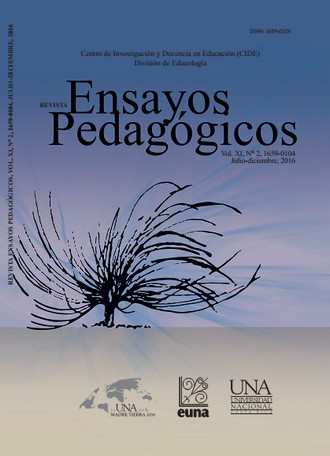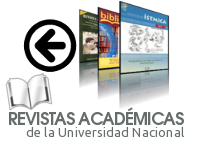Workshop: Training for the Teachers of English at CEIC, in Alajuela, on Web 2.0 Tools that Can Be Used with their Students in Order to Promote the Use of English Outside of the Classroom, Focusing on the Oral Production (Speaking Skill)
DOI:
https://doi.org/10.15359/rep.11-2.8Palabras clave:
Web 2.0 tools, speaking skill, teachers, workshop, training, TELL, Connectivism, SMLLResumen
This article reports on the findings of research carried out to analyze the methodology and prior knowledge on Web 2.0 of the teachers at Centro de Estudios en Inglés Conversacional (CEIC) in Alajuela in order to design and implement a workshop on Web 2.0 tools to train them so that they could promote the use of the speaking skill outside the class with their students. To collect data, three instruments were used, a questionnaire to determine the methodology and previous knowledge of the teacher, a second questionnaire to assess the workshop, facilitator and outcomes of the workshop, and a final questionnaire for the teacher to carry out a SWOT analysis of three oral tasks created using Web 2.0 tools. The data collected were analyzed based on predetermined categories of analysis. In general, the findings obtained point to the fact that teachers are willing to implement and find the use of Web 2.0 tools helpful when aiming to promote the use of the speaking skill outside the classes.
Referencias
Baxter, P. & Jack, S. (2008). Qualitative Case Study Methodology: Study Design and Implementation for Novice Researchers. The Qualitative Report, 13 (4), 544-559. Retrieved from http://www.nova.edu/ssss/QR/QR13-4/baxter.pdf
Belloch, C. (2012). Las tecnologías de la información y comunicación en el aprendizaje. Retrieved from http://www.uv.es/bellochc/pedagogia/EVA1.pdf
Castro, S., Guzmán, B. & Casado, D. (2007). Las Tic en los procesos de enseñanza y aprendizaje. Laurus, 13 (23) 213-234. Retrieved from http://www.redalyc.org/articulo.oa?id=76102311
Chaves , O. & Villalobos, N. (2009). Let’s make our students talk while sharing for learning. 1st TESOL/Applied Linguistics/Foreign Language Conference, 25, 44-559. Retrieved from http://www.una.ac.cr/bibliografia_/components/com_booklibrary/ebooks/letsmakestudentstalk_ochaves_nvillalobos.pdf
Coll, C., Onrubia, J. & Mauri, T. (2007). Tecnología y prácticas pedagógicas: las TIC como instrumentos de mediación de la actividad conjunta de profesores y estudiantes. Anuario de Psicología, 38(3), 377-400. Retrieved from http://www.redalyc.org/articulo.oa?id=97017407003
Duke, B., Harper G., & Johnston, M. (2013). Connectivism as a Digital Age Learning Theory. The International HETL Review. Retrieved from https://www.hetl.org/wp-content/uploads/2013/09/HETLReview2013SpecialIssueArticle1.pdf
Eisner, E. W. (1998). The enlightened eye. Qualitative inquiry and the enhancement of educational practice. Chicago, IL: Prentice Hall.
McDougald, J. (2005). The Use of Modern Technology in the EFL Classroom. An Evaluation of Technology as a Tool in Language Teaching. Retrieved from http://www.academia.edu/238191/THE_USE_OF_MODERN_TECHNOLOGY_IN_THE_EFL_CLASSROOM._AN_EVALUATION_OF_TECHNOLOGY_AS_A_TOOL_IN_LANGUAGE_TEACHING
Moqbel, M. & Padmarani, L. (2013). Enhancing EFL Teaching and Learning through Technology. International Journal of Social Science Tomorrow, 2(2), 1-9. Retrieved from https://www.academia.edu/2629226/Enhancing_EFL_Teaching_and_Learning_Through_Technology
Motteram, G. & Sharma, P. (2009). Blending Learning in a Web 2.0 World. International Journal of Emerging Technologies & Society, 7 (2) 83-96. Retrieved from http://ICT’saugustine.pbworks.com/f/Blending+Learning+in+a+Web+2+World.pdf
Mujtaba, S. & Mubarak, M. (2013). The Use of Computer Technology in EFL Classroom: Advantages and Implications. International Journal of English Language & Translation Studies, 1(1), 61-71. Retrieved from http://eltsjournal.org/pdf_files/The%20Use%20of%20Computer%20Technology%20in%20EFL%20Classrooms%20Advantages%20%26%20Implication-Full%20Paper.pdf
Pizarro, G. & Cordero, D. (2013). ICT’S as a Technological Tool for the Development of Language Skills in Second Language University Students. Revista Electrónica Educare, 17(3), 277-292. Retrieved from http://www.revistas.una.ac.cr/index.php/EDUCARE/article/view/5246/5458
PodOmatic. (2015). Company Overview. Retrieved from http://www.podomatic.com/about
Ramírez, J. (2009). Online Resources for Improving EFL Teaching and Learning. Letras, 2 (46), 103-124. Retrieved from http://www.revistas.una.ac.cr/index.php/letras/article/view/1660
Siemens, G. (2009). Connectivism: A Learning Theory for the Digital Age. Elearnspace. Retrieved from http://www.elearnspace.org/Articles/connectivism.htm
Sitthirak, C. (2013). Social Media for Language Teaching and Learning. Retrieved from https://www.academia.edu/2612052/Social_Media_for_Language_Teaching_and_Learning
Stepp-Greany, J. (2002). Student perceptions on language learning in a technological environment: implications for the new millennium. Language Learning & Technology, 6 (1) 165-180. Retrieved from http://www.llt.msu.edu/vol6num1/pdf/steppgreany.pdf
Tresnick, A. (2010). 7 Social Networks Designed to Help You Learn A New Language. Retrieved from http://www.adweek.com/socialtimes/7-social-language-learning/29269
Villalba, A. (2007-2008). Recursos de la Web 2.0 para la Enseñanza de Idioma. Varona’s Institute. Retrieved from http://ced.cele.unam.mx/ciberestrategias/wp-content/uploads/20 09/11/villalba_web2.pdf
Voki. (2015). About Voki. Retrieved from http://www.voki.com/about_voki.php
WeSpeke. (2015). About WeSpeke. Retrieved from http://en-us.wespeke.com/about.html
Zimmerman, L. (2009). ESL/EFL Teachers and How They Use Technology. ETC Journal. Retrieved from http://etcjournal.com/2009/06/03/eslefl-teachers-and-how-they-use-technology/
Descargas
Publicado
Cómo citar
Número
Sección
Licencia
La Revista Ensayos Pedagógicos está suscrita a la Licencia Creative Commons Atribución-NoComercial-SinDerivadas 4.0 Internacional, lo cual implica la posibilidad de que tanto las personas autoras como las personas lectoras puedan, de forma gratuita, descargar, almacenar, copiar y distribuir la versión final aprobada y publicada (post print) del artículo, siempre y cuando se realice sin fines comerciales, no se generen obras derivadas y se mencione la fuente y autoría de la obra. Asimismo, la Revista Ensayos Pedagógicos declara que toda persona autora conservará a perpetuidad los derechos de autoría de su ensayo o artículo.









